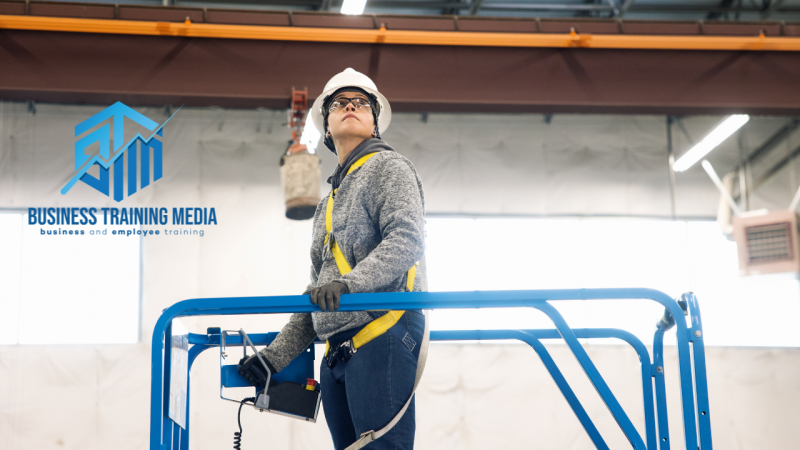
Aerial Lifts Safety Guide for Construction Sites
By Business Training Media
Aerial lifts are commonly used in construction sites to provide workers with access to elevated areas. However, operating aerial lifts can be hazardous if proper safety precautions are not followed. This safety guide aims to provide construction site personnel with essential guidelines to ensure the safe and efficient use of aerial lifts.
1. Pre-Operation Safety Checks:
1.1 Conduct a thorough inspection of the aerial lift before each use, including checking for any signs of damage, leaks, or worn-out components.
1.2 Verify that all safety devices, such as guardrails, safety harnesses, and emergency stop buttons, are in place and functional.
1.3 Check the weight capacity of the lift to ensure it can safely accommodate the intended load.
1.4 Inspect the surrounding area for potential hazards, such as overhead power lines, unstable surfaces, or obstructions.
2. Operator Training and Certification:
2.1 Only trained and certified operators should be allowed to operate aerial lifts. Ensure that all operators have received proper training on the safe operation of the specific type of aerial lift being used.
2.2 Training should cover topics such as equipment controls, emergency procedures, fall protection, and safe operating practices.
2.3 Regularly refresh operator training to keep up with the latest safety standards and best practices.
3. Personal Protective Equipment (PPE):
3.1 All personnel working with or near aerial lifts should wear appropriate PPE, including hard hats, high-visibility vests, safety glasses, and non-slip footwear.
3.2 Operators must use a full-body harness and lanyard attached to an appropriate anchor point when working at heights or in elevated positions.
4. Fall Protection:
4.1 Ensure that guardrails are properly installed and functional on all sides of the aerial lift platform. Never remove or modify guardrails.
4.2 Encourage the use of a safety harness and lanyard as an additional precaution, especially when operating in windy conditions or near potential fall hazards.
5. Safe Operation:
5.1 Before operating the lift, familiarize yourself with all controls, including emergency stop buttons, steering mechanisms, and platform movement controls.
5.2 Do not exceed the load capacity of the aerial lift. Account for the weight of tools, equipment, and personnel.
5.3 Keep both feet firmly on the platform floor while the lift is in operation and never climb or lean over the guardrails.
5.4 Avoid sudden movements and maintain a slow, controlled speed, especially when maneuvering the lift or approaching elevated positions.
5.5 Be aware of the surroundings at all times. Watch out for uneven surfaces, overhead obstructions, or other potential hazards.
5.6 Avoid operating the lift during adverse weather conditions, such as high winds, thunderstorms, or heavy rain.
5.7 Maintain a safe distance from overhead power lines—keep at least 10 feet away unless appropriate precautions, such as using dielectric insulating devices, are taken.
6. Communication and Signaling:
6.1 Establish clear communication protocols between operators and ground personnel.
6.2 Use standardized hand signals or two-way radios to convey instructions or warnings effectively.
6.3 Ensure that all workers in the vicinity are aware of ongoing aerial lift operations.
7. Emergency Procedures:
7.1 Familiarize all personnel with the emergency procedures specific to the aerial lift being used, including how to safely lower the platform in case of a power failure.
7.2 Develop and implement an emergency rescue plan to retrieve personnel in the event of a malfunction or suspension at height.
7.3 Regularly conduct drills to ensure all workers understand their roles and responsibilities during an emergency situation.
Following these aerial lifts safety guidelines will help minimize the risk of accidents and injuries on construction sites.
© Copyright 2023: Business Training Media, Inc.
Join Our Free HR Training Solutions eNewletter
Join our free HR Training Solutions eNewsletter today to stay up-to-date on the latest industry trends, training and development programs, best practices, and expert insights. Gain valuable knowledge, enhance your skills, improve your organization, build productive teams and elevate your career. Don't miss out on this invaluable resource – sign up now for our free HR Training Solutions eNewsletter!

Aerial Lifts in Industrial and Construction Environments: Types of Lifts and Their Hazards
Our Aerial Lifts in Industrial and Construction Environments: Types of Lifts and Their Hazards" is the first of a of a two-part series that has been designed to meet OSHA's training requirements in their "Mobile Elevated Work Platforms" (MEWPs) standard.




